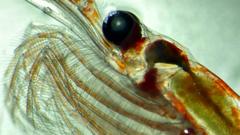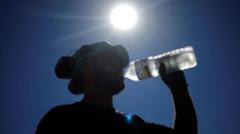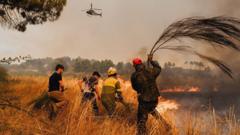Tiny creatures called zooplankton, primarily known as aquarium food, are reported to make substantial contributions to combating global warming through their remarkable migration patterns. Research reveals these inconspicuous heroes gorge on food during spring and then descend into the depths of the southern ocean, where they consume their stored fat. This process effectively locks away an amount of carbon equal to the emissions of around 55 million petrol cars annually, offering a vital service in mitigating climate change effects. However, their survival is now threatened by various environmental changes.
Professor Daniel J. Mayor, who studies these organisms at the University of Exeter, emphasizes the importance of these tiny animals in storing carbon. According to lead researcher Dr. Guang Yang from the Chinese Academy of Sciences, their role in the Southern Ocean could be underestimated, necessitating a revised understanding of carbon storage in this region. Co-author Dr. Jennifer Freer of the British Antarctic Survey also notes that these creatures are often overshadowed by larger, more celebrated Antarctic wildlife like whales and penguins.
Zoologists have been exploring the zooplankton’s unique life cycle—specifically copepods, krill, and salps—and their ability to feast upon phytoplankton located on the ocean's surface. When these creatures feed, they accumulate fat that serves as an energy reserve. As they descend to deeper waters, they burn the fat slowly, thus releasing carbon dioxide at significant depths where it may remain for decades, effectively reducing its contribution to atmospheric warming.
The latest findings indicate that through what scientists refer to as the seasonal vertical migration pump, about 65 million tonnes of carbon are transported annually beneath the ocean’s surface, with copepods leading the pack in contributions. This process has been quantified extensively through data spanning back to the 1920s, highlighting how critical these organisms are in maintaining the ocean’s ability to sequester carbon.
Despite these findings, the future of zooplankton remains precarious. Climate change, disturbances in oceanic layers, and extreme weather conditions are burgeoning threats to their habitats. Furthermore, the commercial harvesting of krill is raising concerns; nearly half a million tonnes were caught in 2020 alone, prompting calls for regulatory scrutiny to safeguard this vital food web component against exploitation.
Scientists argue that recent discoveries should be integrated into climate change models to improve predictions on global temperature rises. The research, published in the journal Limnology and Oceanography, serves as a vital reminder of the interconnectedness of ocean life and climate health, underscoring that without the biological contributions of zooplankton, atmospheric CO2 levels could theoretically double. This highlights the crucial role these tiny creatures play in global warming mitigation, reinforcing the need for ongoing conservation efforts.





















